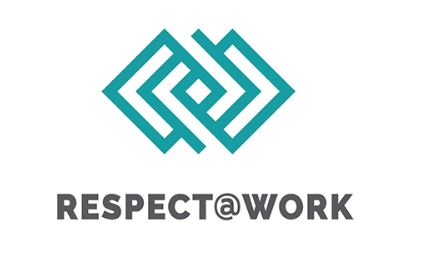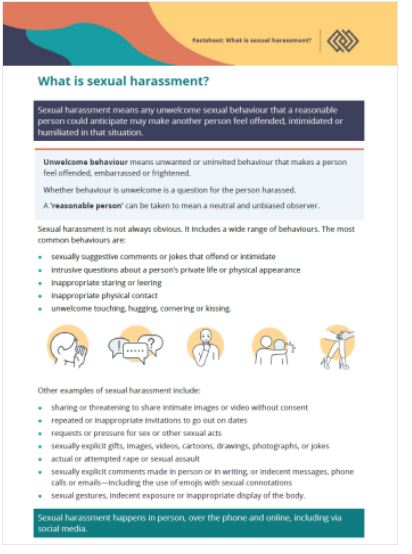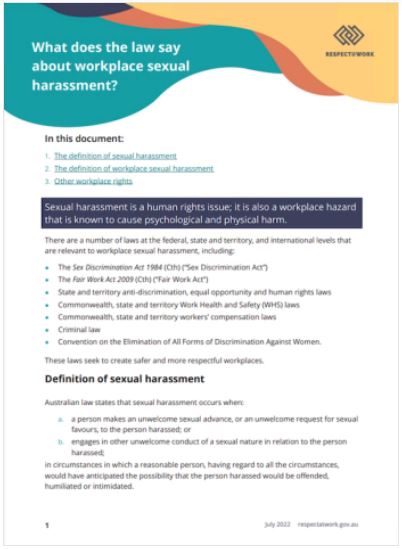Respectful workplaces
Content warning: this page includes information on sexual and gender-based harassment and may be distressing for some people. See Support and contact if you or someone you know needs support.
Under Australian laws, organisations and their employees have responsibility to take proactive and meaningful action to eliminate, as far as possible, and prevent sexual harassment and gender-based harassment at work.
The short-courses and factsheets on this page will help you understand unlawful workplace sexual and gender-based harassment, the impacts of these behaviours, your responsibilities and how you're protected under the law.
While harassment on the ground of gender and sexual harassment can occur in combination, the behaviours constituting each differ in nature:
- Sexual harassment is any unwelcome sexual behaviour that a reasonable person could anticipate may make another person feel offended, humiliated or intimidated in that situation. It can also occur in a sexually charged or ‘hostile’ work environment, even if the conduct is not directed at a specific person.
- Gender-based harassment is unwelcome conduct of a seriously demeaning nature by reason of a person’s sex characteristics, sexual orientation, and/or gender identity in which a reasonable person would have anticipated the possibility that the person harassed would be offended, humiliated or intimidated.
Under the relevant legislation, all members of the Charles Sturt community have responsibilities, including:
- Employers - have a responsibility to do everything they reasonably can to make sure the workplace is safe including taking action to prevent, and respond to, workplace sexual harassment.
- Officers (key decision makers) - must exercise due diligence to ensure that the organisation complies with WHS obligations.
- Workers - are responsible for taking reasonable care of their own health and safety while at work, and not negatively impacting the health and safety of others. This includes not sexually harassing others and following reasonable instructions from their employer.
- Others in the workplace (e.g. customers, clients and patients) - are responsible for taking reasonable care of their own health and safety, and not negatively impacting the health and safety of others. This includes not sexually harassing others and following reasonable instructions relating to health and safety.
If you or someone you know is in a life-threatening situation, please:
Call Triple Zero (000)
for police, fire brigade or ambulance assistance
-
Quicklinks
chevron_right
Education and training
The Respect@Work website was developed in response to recommendation 48 of the National Inquiry into Sexual Harassment in Australian Workplaces. The site brings together resources to support individuals and organisations to better understand, prevent and address workplace sexual harassment.
The free online courses below were developed by Respect@Work to help you better understand workplace sexual harassment, its impact, your responsibilities and how you're protected.
-
What is sexual harassment? chevron_right
1 in every 3 people have experienced sexual harassment at work in the last five years. Despite the prevalence of sexual harassment in Australian workplaces, many people find it hard to define sexual harassment, and are not familiar with the wide range of behaviours that can constitute workplace sexual harassment.
This micro-module will increase your understanding of:
- the definition of sexual harassment, and
- the types of behaviour that are considered sexual harassment
-
What are the impacts of workplace sexual harassment? chevron_right
The impacts of workplace sexual harassment are profound and devastating for both individuals and workplaces. Crucially, workplace sexual harassment, and its impacts, are preventable.
This micro-module will increase your understanding of the broad-reaching impacts of workplace sexual harassment.
-
How does the law protect you from sexual harassment? chevron_right
Workplace sexual harassment is against the law in Australia. Sexual harassment includes a wide range of different behaviours. If a person is sexually harassed in the course of their work or in connection to work, is likely to be against the law.
This micro-module will increase your understanding of:
- which laws prohibit workplace sexual harassment
- who is protected
- how the law interprets ‘workplace’
- how your workplace rights are protected
-
Who is responsible for preventing workplace sexual harassment? chevron_right
Everyone has the right to be safe while working. The law requires workers and organisations to prevent and address workplace sexual harassment. Those who do not adhere to their responsibilities can be held liable.
This micro-module will increase your understanding of:
- the responsibilities of workers to prevent workplace sexual harassment
- the responsibilities of organisations to prevent sexual harassment
- who is liable if workplace sexual harassment occurs.
-
What can you do if you are sexually harassed at work? chevron_right
In Australia, sexual harassment in the workplace is against the law. Employers are legally responsible for ensuring that you have a safe working environment and for preventing workplace sexual harassment.
Sexual harassment can cause psychological and physical harm and should not be ignored. If you are sexually harassed in the workplace, there are a number of options you can take to get support, seek advice or report the behaviour.
This micro-module will increase your understanding of:
- where to get support
- where to seek advice
- where you can report harassment.
-
Workplace sexual harassment: key facts chevron_right
In 2018, the Australian Human Rights Commission conducted the Fourth national survey on sexual harassment in Australian workplaces. The results provide a rich collection of data on the experiences of sexual harassment of Australians aged 15 to 65.
This micro-module explores this data, focusing on:
- the forms workplace sexual harassment can take
- who the harassers are
- who is being sexually harassed at work
- workplace industries and settings that have a higher prevalence of workplace sexual harassment
- who witnesses sexual harassment.
-
Workplace sexual harassment: what you need to know chevron_right
This eLearning course is designed for younger workers, but others may also find it useful. Anyone is welcome to take this course.
Australian law says that everyone has the right to a workplace that is safe. There are a number of laws that lay out the workplace rights that everyone is entitled to. This course explains your rights in relation to workplace sexual harassment.
It will provide you with key information about workplace sexual harassment, including:
- The definition of sexual harassment
- The definition of workplace sexual harassment
- The causes of workplace sexual harassment
- Your rights under the law
- What to do if you are sexually harassed at work
- Where can you get help if you are sexually harassed at work
- Reporting workplace sexual harassment
Factsheets
These factsheets, developed by Respect@Work, explain sexual harassment and its causes in workplace settings. They also provide information about relevant Australian laws and what you can do if you're sexually harassed at work.
What can you do if you are sexually harassed at work?
Support and contact
Support is available if you have been impacted by sexual harassment at work.
Complaints
Charles Sturt has a zero-tolerance approach to sexual harassment and expects staff to always conduct themselves in a respectful and professional manner.
If you have been involved in an incident of sexual or gender-based harassment, you can report it via your supervisor (where possible), the relevant Division of People and Culture Human Resources Business Partner or submit a complaint through the University’s complaint management system. In addition, you can make a formal report to the police.
Support
Workplace sexual and gender-based harassment can have significant impacts on the health and wellbeing of any person who experiences or witnesses it. A range of free support services are available including:
- 1800RESPECT – 24/7 confidential counselling and support. Phone: 1800 737 732 or visit 1800respect.org.au
- Lifeline – 24/7 crisis support and suicide prevention. Phone: 13 11 14 or visit lifeline.org.au
- 13Yarn – 24/7 culturally safe crisis support for First Nations people. Phone: 13 92 76 or visit 13yarn.org.au
- Mensline – free confidential counselling and support for men. Phone: 1300 78 99 78 or visit mensline.org.au
- Converge, Charles Sturt’s Employee Assistance Provider (EAP) is available to all staff and critical incident support is available for any staff who have been exposed to a traumatic event at work, they also provide support to managers. Phone: 1300 687 327 or learn more about the EAP





